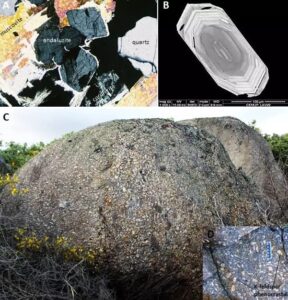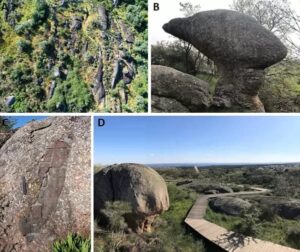To the Editor
The Castelo Branco pluton is located within the Central Iberian Zone of the Iberian Massif, central Portugal (39˚49´N, 7˚29´E), in the territory of Naturtejo UNESCO Global Geopark (Fig.1). It is a composite and zoned intrusion of peraluminous affinity, with five concentric belts of Variscan granitic rocks (age: 310+1 Ma; Antunes et al. 2008), exposed over an area of 390 km2, which intruded a Neoproterozoic-to-lower (?) Cambrian turbidite succession (Beiras Group), and also a biotite granodiorite of 480±2 Ma towards Northeast (Antunes et al. 2009). The pluton was intrusive at a higher level than the source area, emplaced in an epizonal domain and late-orogenic, forming a roughly circular body, as an unusual reversely zoned pluton (with a felsic rim and a more mafic core). It is affected by an important ENE-WSW late-Variscan tectonic fault system.

Figure 1. Geological setting of the “Barrocal” Park (blue square) in the southern tip of the Castelo Branco late-Variscan pluton, at the heart of Naturtejo UNESCO Global Geopark.
The Castelo Branco pluton is composed of rocks with a composition that varies between granite and granodiorite, and the Barrocal Granite occurs mainly in the border of the pluton. The Barrocal Granite is a two-mica granite, surrounding a granodiorite, through a gradual contact, with a symmetrical external shape, and various NE-SW faults crossing it. It contains quartz, plagioclase, micropertitic microcline, biotite, muscovite, and tourmaline. Andalusite and cordierite also occur (Fig.2A), and occasionally, some sillimanite with monazite, apatite, zircon (Fig.2B), ilmenite and rutile, as accessory minerals. K-feldspar phenocrystals are up to 10 cm long and are generally fractured, locally aligned with the magmatic flow (Fig.2C, D).

Figure 2. Barrocal Granite from the Castelo Branco pluton at “Barrocal” Park: A) euhedral andalusite fractured and included in muscovite, with sillimanite and associated cordierite (x 25). B) Zircon (BSE - Backscattered Electron Image). C) and D) K-feldspar phenocrystals concentrated by magmatic flow (vertical, from below given by the rotation of the crystals at the left border) intersecting a granite mass of sparsely distributed, sub-horizontal phenocrystals.
The Barrocal Granite contains enclaves from the granodiorite with which it contacts, indicating that these granitic rocks are related by a petrogenetic process. The geochemical variation of major and trace elements of the peraluminous granite rocks suggests a magma differentiation process in the Castelo Branco pluton. The whole-rock geochemistry and isotopic data (87Sr/86Sr310; εNd310, and δ18O) support that the Barrocal Granite results from in situ fractional crystallization of the granodiorite magma, controlled by separation of plagioclase, quartz, biotite, and ilmenite, which took place outwards in maximum two million years (Antunes et al. 2008).
The emplacement of the Barrocal Granite started at about 30 km depth and temperature of 750˚C, with a quite slow ascent of cooling magma, including different crystallization mineral processes. At the early slower cooling process, phenocrystals grew up in equilibrium with the residual magmatic fluids and were distinguished from the matrix, sometimes aligned according to the magmatic flow and in high concentrations. The remained minerals solidified through progressive crystallization, with temperature and depth decrease, which took 4 Ma (Antunes et al. 2008; Antunes et al. 2009). The geological, mineralogical, geochemical, and isotopic data indicate a crustal origin of the suite, likely from partial melting of the intruded turbidite succession, which is found in decimetrical to metrical xenoliths within the Barrocal Granite .
After a very long period of peneplain evolution, the Castelo Branco pluton was finally unroofed during the Eocene (Cunha 2019). The Barrocal granite dome and associated landforms were developed in the last ~1.8 Ma, in relation to the incision of the Tejo river system into the peneplain (Gouveia et al. 2019). Weathering and erosional processes succeeded according to the climate changes during the Quaternary, shaping the diversity of textbook-like granite landforms (Migoń 2006), from the scale of the minerals to over 100 m long, dome-shaped massive rock outcrops, including weathering pits, pedestal rocks, flared surfaces, jointed boulders, polygonal cracks, etching surfaces, xenolith differential erosion and elongated boulders (Neto de Carvalho 2017; Fig. 3A,B).
The geoheritage value of Barrocal area at the city of Castelo Branco can then be summarized as follows:
1. The Barrocal Granite is one of the main lithofacies of the reversely zoned Castelo Branco granite pluton, which turns out to be a particular case of S-type magmatic pluton within a now well-known evolution of the Variscan Orogen in this part of the Central Iberian Zone. The outcrops are rich in large enclaves and xenoliths (Fig. 3C) which provide a great geochemical source of data. They also have educational importance since students can clearly understand the genetic relation of the metasedimentary protolith of this granite intrusion by finding well-bedded metasedimentary relic enclaves that are identical to the shales and metagreywackes from the Neoproterozoic Beiras Group cropping out around in the city. They can also realize different directions of magmatic flow during the process of intrusion, by observing and measuring the concentrations of aligned phenocrystals;
2. Barrocal Park shows representative and diverse granite landforms, which are from tourist value due to the aesthetic landscape interest, and ecological importance as habitats for an important variety of plants adapted to silica-rich rocks and soils, but also from educational value because granite landforms were shaped during different bioclimate conditions which make them examples of climate change;
3. Barrocal is of great ethnographical importance for the history of the city of Castelo Branco, as remains from human occupation and sacred modification of this landscape, as early as the Bronze Age, were recently found.
Finally, to highlight the importance of the geoheritage value of this granitic landscape, 40 ha of land were bought by the municipality of Castelo Branco and a park was developed almost in the center of the city of Castelo Branco, representing an investment of over 1 million Euros, in its first stage. The aim of the “Barrocal” Park is to provide protection and access to an old quarried area, currently subject to natural regeneration, through a system of raised paths and viewpoints designed to respect and highlight the experience with granitic landforms (Fig. 3D), as well as to support the interpretation of landscape and environmental activities related to climate change and erosion, granite soil-adapted biodiversity and pre-historical and ethnographical land use. This new attraction of Naturtejo UNESCO Global Geopark, located in the urban area close to city center, will bring the geopark closer to the local community at the same time that increases the geotourism offer and diversity in the geopark. In November, during the first week of opening, and despite all the constraints of the emergency alert at a national level during the second wave of the COVID-19 pandemic, the Barrocal Park was visited by 1000 people. This project was recently the winner of the world architecture Wan Awards 2020 in the category of Urban Landscapes.

Figure 3. The “Barrocal” Park: A) view of the “Barrocal” Park landforms developed by the proximity of a fault into elongated boulders up to 100 m long (Photo credit: Pedro Martins). B) Pedestal rock with elongated cap according to the slope and marks of the weathering-erosion cycles in the pedestal. C) Relic enclave of shales from Beiras Group turbidites as the protolith of the S-type Barrocal Granite magma. D) Detail of the “Barrocal” city Park highlighting nature conservation and enjoyment through pathways and viewpoints (wooden structure in the horizon).
Acknowledgments
This paper is part of the project “Barrocal” Park of the city of Castelo Branco that was coordinated by the company Topiaris – Landscape Architecture Projects, to which the IMHRA and CNC would like to thank the invitation to take part in the scientific team, in the person of its CEO, Teresa Barão. We would like to thank Piotr Migoń (University of Wroclaw) and another anonymous reviewer for their comments that improved considerably this paper.
